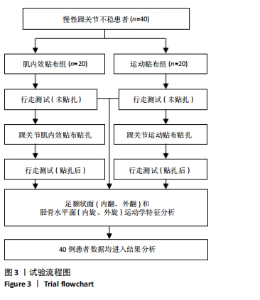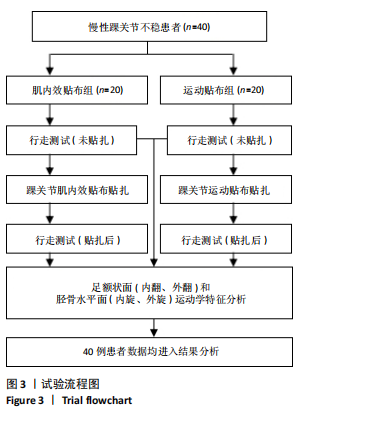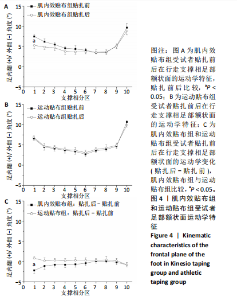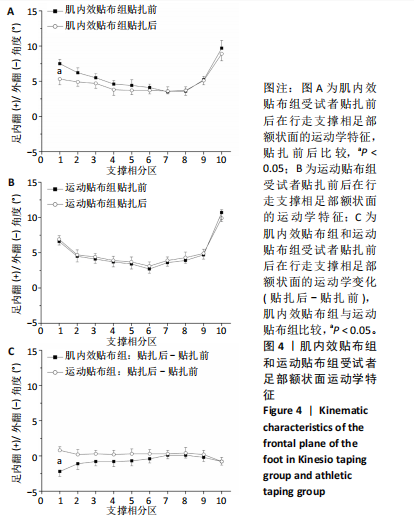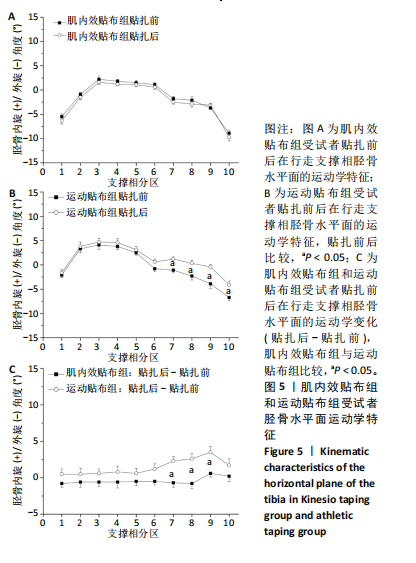[1] HERZOG MM, KERR ZY, MARSHALL SW, et al. Epidemiology of ankle sprains and chronic ankle instability. J Athl Train. 2019;54(6):603-610.
[2] DHILLON MS, PATEL S, BABURAJ V. Ankle sprain and chronic lateral ankle instability: optimizing conservative treatment. Foot Ankle Clin. 2023;28(2):297-307.
[3] KOLDENHOVEN RM, JAFFRI AH, DEJONG AF, et al. Gait biofeedback and impairment-based rehabilitation for chronic ankle instability. Scand J Med Sci Sports. 2021;31(1):193-204.
[4] CHINN L, DICHARRY J, HART JM, et al. Gait kinematics after taping in participants with chronic ankle instability. J Athl Train. 2014;49(3): 322-330.
[5] HERB CC, CHINN L, HERTEL J. Altering shank-rear-foot joint coupling during gait with ankle taping in patients with chronic ankle instability and healthy controls. J Sport Rehabil. 2016;25(1):13-22.
[6] HORNESTAM JF, ARANTES P, SOUZA TR, et al. Foot pronation affects pelvic motion during the loading response phase of gait. Braz J Phys Ther. 2021;25(6):727-734.
[7] 王玲,陈鹏,王广兰,等.肌内效贴对慢性踝关节不稳的影响:系统综述和Meta分析[J].中国组织工程研究,2023,27(14):2283-2290.
[8] 尹璐璐,王琳.肌内效贴对慢性踝关节不稳运动神经肌肉控制的影响[J].中国组织工程研究,2020,24(11):1783-1789.
[9] ZIAEI ZIABARI E, HAGHPANAHI M, RAZI M, et al. The effects of chronic ankle instability on the biomechanics of the uninjured, contralateral ankle during gait. Orthop Surg. 2022;14(9):2238-2244.
[10] 马乾峰,丁健,李立,等.基于矢量编码技术研究功能性踝关节不稳者下肢协调性和变异性[J].医用生物力学,2023,38(6):1086-1092.
[11] 李淑媛,朱磊,张亚楠,等.Cumberland踝关节不稳定评定问卷的汉化与信度、效度分析[J].中国运动医学杂志,2011,30(9):814-819.
[12] 姚军威,程阳,韦俏丽,等.贴扎对慢性踝关节不稳的男性篮球运动员正向和侧向跳跃时踝关节运动学特征的影响[J].中华物理医学与康复杂志,2023,45(1):53-60.
[13] SARVESTAN J, AGHAIE ATAABADI P, SVOBODA Z, et al. Ankle-knee coupling responses to ankle Kinesio™ taping during single-leg drop landings in collegiate athletes with chronic ankle instability. J Sports Med Phys Fitness. 2021;61(4):582-591.
[14] 尤婧,黄文琪,郑尉,等.肌内效贴对下肢侧切运动中生物力学特征的影响[J].中国组织工程研究,2024,28(27):4383-4389.
[15] DE RIDDER R, WILLEMS TM, VANRENTERGHEM J, et al. Effect of tape on dynamic postural stability in subjects with chronic ankle instability. Int J Sports Med. 2015;36(4):321-326.
[16] ZENI JA JR, RICHARDS JG, HIGGINSON JS. Two simple methods for determining gait events during treadmill and overground walking using kinematic data. Gait Posture. 2008;27(4):710-714.
[17] SHIN YJ, LEE JH, CHOE YW, et al. Immediate effects of ankle eversion taping on gait ability of chronic stroke patients. J Bodyw Mov Ther. 2019;23(3):671-677.
[18] NUNES GS, FELDKIRCHER JM, TESSARIN BM, et al. Kinesio taping does not improve ankle functional or performance in people with or without ankle injuries: Systematic review and meta-analysis. Clin Rehabil. 2021;35(2):182-199.
[19] FAYSON SD, NEEDLE AR, KAMINSKI TW. The effect of ankle Kinesio tape on ankle muscle activity during a drop landing. J Sport Rehabil. 2015;24(4): 391-397.
[20] DELAHUNT E, MONAGHAN K, CAULFIELD B. Altered neuromuscular control and ankle joint kinematics during walking in subjects with functional instability of the ankle joint. Am J Sports Med. 2006;34(12): 1970-1976.
[21] MONAGHAN K, DELAHUNT E, CAULFIELD B. Ankle function during gait in patients with chronic ankle instability compared to controls. Clin Biomech (Bristol, Avon). 2006;21(2):168-174.
[22] ALAWNA M, MOHAMED AA. Short-term and long-term effects of ankle joint taping and bandaging on balance, proprioception and vertical jump among volleyball players with chronic ankle instability. Phys Ther Sport. 2020;46:145-154.
[23] MIGEL K, WIKSTROM E. Gait Biomechanics following taping and bracing in patients with chronic ankle instability: a critically appraised topic. J Sport Rehabil. 2020;29(3):373-376.
[24] BIZ C, NICOLETTI P, TOMASIN M, et al. Is Kinesio taping effective for sport performance and ankle function of athletes with chronic ankle instability (CAI)? A systematic review and meta-analysis. Medicina (Kaunas). 2022;58(5):620.
[25] LEARDINI A, BENEDETTI MG, BERTI L, et al. Rear-foot, mid-foot and fore-foot motion during the stance phase of gait. Gait Posture. 2007;25(3):453-462.
[26] DUGAN SA, BHAT KP. Biomechanics and analysis of running gait. Phys Med Rehabil Clin N Am. 2005;16(3):603-621.
[27] AMBEGAONKAR JP, REDMOND CJ, WINTER C, et al. Ankle stabilizers affect agility but not vertical jump or dynamic balance performance. Foot Ankle Spec. 2011;4(6):354-360.
[28] SUN X, LAM WK, ZHANG X, et al. Systematic review of the role of footwear constructions in running biomechanics: implications for running-related injury and performance. J Sports Sci Med. 2020;19(1): 20-37.
[29] VERTULLO CJ, CADMAN J, DABIRRAHMANI D, et al. Can tape-screw fixation of a quadrupled semitendinosus graft in a full-length tibial tunnel provide superior fixation compared with a doubled semitendinosus-gracilis held with an interference screw? A matched-pair cadaveric biomechanical comparison. J Orthop Traumatol. 2018; 19(1):e11.
[30] CHANG SH, MORRIS BL, SAENGSIN J, et al. Diagnosis and treatment of chronic lateral ankle instability: review of our biomechanical evidence. J Am Acad Orthop Surg. 2021;29(1):3-16. |
